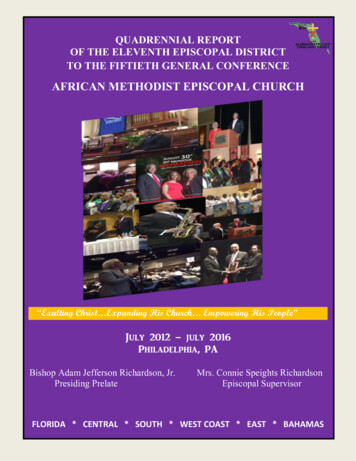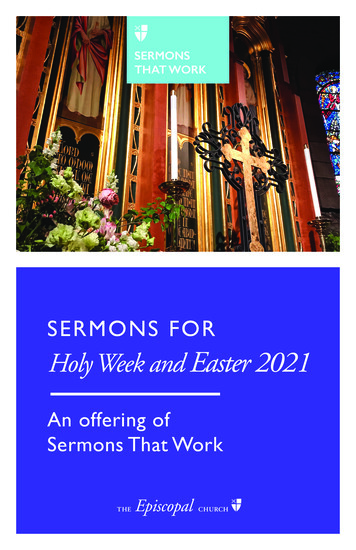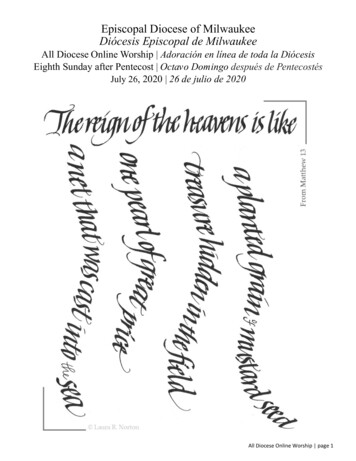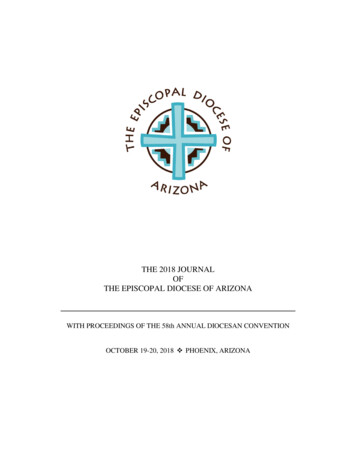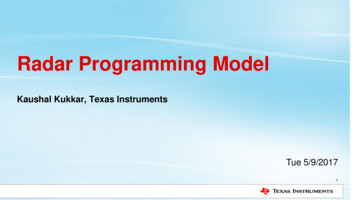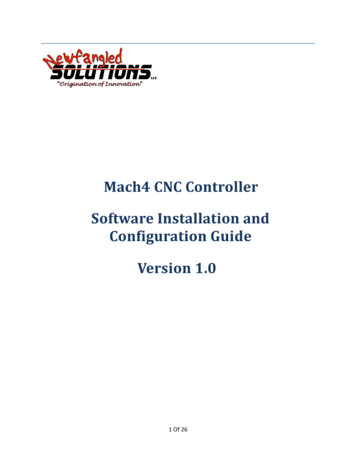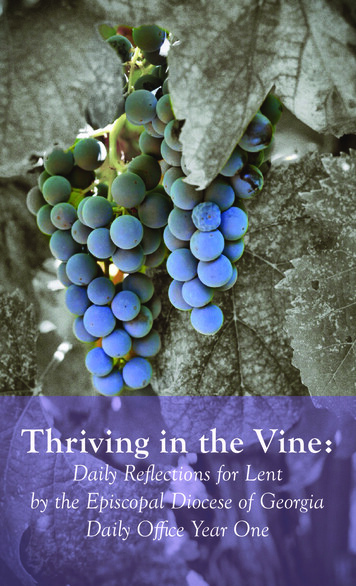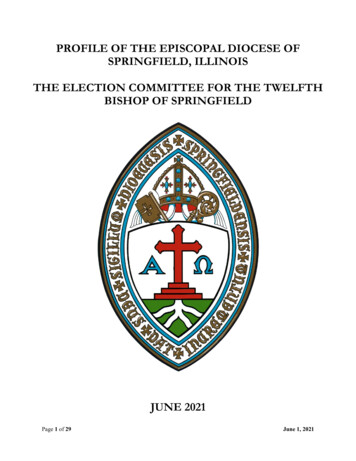
Transcription
PROFILE OF THE EPISCOPAL DIOCESE OFSPRINGFIELD, ILLINOISTHE ELECTION COMMITTEE FOR THE TWELFTHBISHOP OF SPRINGFIELDJUNE 2021Page 1 of 29June 1, 2021
TABLE OF CONTENTS1. AN INVITATION TO DISCERNMENTPage 32. OUR UNIQUE ELECTION PROCESSPage 43. HISTORY OF THE DIOCESEPage 64. STATISTICAL TRENDSPage 75. FINANCIAL TRENDSPage 156. LISTENING PHASE RESULTSPage 16-SURVEYANONYMOUS COMMENTSLISTENING SESSIONSPage 16Page 17Page 207. OUR STORY TOLD THROUGH THE MINISTRY OF OUR CHURCHESPage 238. CLOSING WORDS FROM THE STANDING COMMITTEEPage 289. A PRAYER FOR RENEWAL OF THE CHURCHPage 29Page 2 of 29June 1, 2021
THE ELECTION OF THE 12TH BISHOP OF SPRINGFIELD:AN INVITATION TO DISCERNMENTThe Episcopal Diocese of Springfield invites qualified candidates to discern whether God may be calling them toserve the church of Jesus Christ as the 12th Bishop of Springfield. The Diocese also invites its faithful members todedicate time in prayer and meditation to discern what God is calling the Diocese of Springfield to be and do inorder to further God’s kingdom of love and light within our churches, communities, and region.It is particularly important for qualified nominees, as well as delegates and alternates to the nominating and electingsynods, to engage in spiritual practices supportive of the discernment process. This involves more than aperfunctory ticking of boxes to determine whether a nominee’s own beliefs, preferences, skills, and personalqualities align with the expectations of the Diocese.The Bishop Election Committee, in consultation with the Standing Committee, presents this profile as raw data forpotential nominees, delegates, alternates, and the faithful of the Diocese to “read, mark, learn, and inwardly digest.”It is the story of the Diocese thus far. The story speaks to who we are, what we think, and what we have done.There is little analysis and interpretation provided. You are invited into a prayerful process of discernment fornominees and the Diocese. Ultimately God provides the interpretation of and insight into our story.Therefore, it is incumbent upon all concerned to approach the election of the 12th Bishop of Springfield with anattitude reflected in the words of Mother Teresa of Calcutta: “Come, Holy Spirit, guide me, protect me, and clearout my mind that I can pray.” With a prayerful heart, we can complete the election process and, as the Psalmistwrites, “Be still and know that I am God. I will be exalted among the nations; I will be exalted in the earth.”It is our hope that our next Bishop, under the influence and guidance of the Holy Spirit, will help us write the nextchapter in the story of our Diocese. With God’s help, the next chapter of our story will be greater than our past –for in Jesus the best is yet to be.The Election Committee for the 12th Bishop of the Episcopal Diocese of SpringfieldThe Very Reverend Sherry Black, Chair (March 2020 – May 2021), St. Mark’s, West Frankfort, ILThe Very Reverend Zachary Brooks, Trinity, Jacksonville, ILMary Ann Denney, St. Luke’s, Springfield, ILJan Goosens, St. Thomas’, Glen Carbon, ILWilliam Jackson, St. Luke’s, Springfield, ILJames Keith, St. John’s, Decatur, ILDon Kensell, St. John the Baptist, Mt. Carmel, ILRoy Laws, St. Matthew’s, Bloomington, ILRod Matthews, co-Chair (March 2020 - May 2021), Chair (June 2021 -), Christ the King, Normal, ILCharles Rice, St. Paul’s, Carlinville, ILFredna Scroggins, St. Andrew’s, Edwardsville, ILNorm Taylor, Cathedral Church of St. Paul, Springfield, ILBill Techau, Emmanuel Memorial, Champaign, ILKelley Wegeng, The Chapel of St. John the Divine, Champaign, ILThe Reverend David Wells, Cathedral Church of St. Paul, SpringfieldPage 3 of 29June 1, 2021
OUR UNIQUE ELECTION PROCESSPart of the story of the Diocese of Springfield is its uniquely transparent process for electing a bishop. There is nosearch committee that assembles a slate; instead, anyone who completes the nomination process and passes therequired reference and background checks will be a nominee.A letter from the Very Rev. Ronald H. Clingenpeel, elections consultant from the Office of Pastoral Developmentof the Episcopal Church speaks to our process:Greetings in Jesus Christ,The Diocese of Springfield is a wonderful and special place in the Episcopal Church. It is like no other diocese – which,frankly, is true of every diocese. Each has its own history and life and culture. This diocese does things a bit differently, and that isgood, because by working with and viewing others we find ways in which we can grow. Besides, would it not be boring if every diocesewere exactly the same? We learn from one another and the election ministry of the Diocese of Springfield is helpful to the rest of theChurch.I am a search consultant with more than 20 years of experience in Episcopal elections. Working with more than 25 dioceses, I havediscovered many new and helpful ways in which to improve the process. When Springfield began this current process, the Office ofPastoral Development of the Episcopal Church asked to place an election consultant here to learn from this diocese and bring theselearnings to the Church. Already, that participation has paid dividends as the Diocese of Ecuador Central will be using a very similarprocess in their election. Your ministry is affecting another part of the Church.Your process leaves the nominating up to the people. There is no Search Committee, but rather an Election Committee that surveys thediocese, prepares a profile, receives nominations, conducts background checks and references, and then presents the nominees to the diocese.Then the diocese meets in convention to choose the final candidates. Those candidates visit the diocese and then an Electing Conventionchooses the next bishop. This allows for transparency in the process and also proves to be cost effective when searching for a new bishop.Working with your Standing Committee and Election Committee has been a joy and I believe we have learned much from one another.Not only is your process being shared with other dioceses, but the hard work of the communication audit done by your ElectionsCommittee may become a standard recommendation for other dioceses. Your process, and especially the people who are working hard tomake it happen, is something that smaller dioceses can use to streamline what they do; it is something that requires a different focus onselecting a bishop; it is something that brings a tradition forward and still accepts the necessary changes to make it work in the 21stCentury.What happens here makes a difference, not only in the Diocese of Springfield, but in the whole Church. Choosing a bishop affects therest of the Church, but also, the way in which that person is called affects the Church. What you do here is important.The Very Rev. Ronald H. Clingenpeel, Elections ConsultantThe Profile is available, and Nominations are open on June 4, 2021. Nominations close on June 30, 2021. Thenominees who pass the required reference and background checks and their relevant application materials will bemade public to the people of the Diocese no later than September 14, 2021.A Nominating Synod, in conjunction with our Annual Synod, will be held at the Cathedral Church of St. Paul theApostle in Springfield, Illinois, on October 15 and 16, 2021. It will narrow the field to three candidates.Page 4 of 29June 1, 2021
Between October 25 and November 20, 2021, we anticipate providing opportunities for us to meet the threecandidates during visits to locations around the Diocese. During that time, each candidate will take part in separatevideo interviews responding to several additional questions.Finally, there will be an Electing Synod on December 11, 2021, leading to the consecration of the 12th Bishop ofSpringfield on May 21, 2022, pending final checks and consents. The chief consecrator will be The Most Rev.Michael B. Curry, Presiding Bishop and Primate of The Episcopal Church.Year 2021June 1 (Justin, Martyr, 167)Profile, Guidelines, and Nomination Packages are posted and distributedJune 30Deadline for receiving completed Nominations for Bishop from the nominators and nominees.September 14 (Holy Cross Day)Booklet with qualified Nominees distributed to Nominating Synod Delegates and posted to the BishopElection website.October 15/16 (Teresa of Avila {15th}, Hugh Latimer & Nicholas Ridley, Bishops and martyrs, Thomas Cranmer,Archbishop of Canterbury {16th}):Regular Diocesan plus Nominating Synods convene to select candidates for the 12th Bishop of Springfield.Cathedral Church of Saint Paul the Apostle, Springfield, IllinoisOctober 25 (Tabitha (Dorcas) of Joppa) - November 20 (Edmund, King 870):Meet the CandidatesDecember 11:Electing Synod convenes to elect the 12th Bishop of Springfield. Cathedral Church of Saint Paul theApostle, Springfield, IllinoisYear 2022January 14 (Richard Meux Benson, Priest, and Charles Gore, Bishop, 1915 and 1932):The Bishop Elect’s required or supplemental background checks plus required physical and psychologicalexams completedConsent Process beginsHoly Week – April 10 Palm Sunday – April 17 Easter Sunday May 21(Lydia of Thyatira, Coworker of the Apostle Paul)Ordination of the 12th Bishop of Springfield, The Most Rev. Michael Bruce Curry, Presiding Bishop andPrimate of The Episcopal Church, chief consecrator. Location: TBD** NOTE - Dates are subject to change given the Covid19 pandemic and any unforeseen circumstancesPage 5 of 29June 1, 2021
HISTORY OF THE DIOCESEThe story of the Episcopal Diocese of Springfield begins as early as 1821, when the General Board of Missions sentthe Reverend Amos Baldwin to evangelize the American western frontier. During his journeys, Baldwin reportedlyorganized a congregation in Albion, Illinois. However, both the congregation and any records of it disappeared. Acongregation did reemerge in Albion and today St. John’s Episcopal Church is the oldest surviving Episcopal houseof worship in Illinois. Faithful disciples of Jesus Christ have worshipped there since Christmas 1842.The story continued as other missionary priests evangelized Illinois, organizing parishes in communities likeJacksonville (Trinity, 1832) and Chicago (St. James, 1834) and establishing congregations in other areas. In 1835,three priests, and six laypersons from Peoria, Rushville, and Beardstown met in the upper room of a tavern toorganize the Episcopal Diocese of Illinois. The Diocese began with 28 communicants and congregations inJacksonville, Peoria, Rushville, Beardstown, Chicago, and Galena. Subsequently the Right Reverend PhilanderChase became first Bishop of Illinois.By 1876, the task of evangelizing the State of Illinois became so great that the Diocesan Convention established themechanics by which the statewide diocese could grow into three separate regional dioceses. The GeneralConvention of 1877 approved the division. Later that year, in December, the Primary Convention of the newDiocese of Springfield met in the city for which it was named. With Bishop Edward M. McLaren presiding, 13clergy and 31 laypersons attended the meeting and elected Diocesan officers. The Very Reverend George FranklinSeymour, Dean of General Theological Seminary in New York was elected the Bishop of Springfield.The following clergy have served the Diocese in the capacity as indicated:1.2.3.4.5.6.7.8.9.10.11.George Franklin Seymour (Bishop, 1878-1906);Edward William Osborne (Coadjutor 1904-1905; Bishop, 1904-1916);Granville Hudson Sherwood (Bishop, 1917-1923);John Chanler White (Bishop, 1924-1947);Richard Tuttle Loring (Bishop 1947-1948);Charles Asa Clough (Bishop, 1948-1961);Albert Arthur Chambers (Bishop, 1962-1972);Albert William Hillestad (Bishop, 1972-1981);Donald Maynard Hultstrand (Bishop, 1982-1991);Peter Hess Beckwith (Bishop, 1992-2010);Daniel Hayden Martins (Bishop, 03-19-2011 to 06-30-2021).A more detailed history of the Diocese and our eleven episcopates can be found ory/.Page 6 of 29June 1, 2021
STATISTICAL TRENDSThe region encompassed by the Diocese of Springfield provides the setting in which our story of endeavoring to dothe work of Jesus Christ has developed since its early 19th century beginnings. The Diocese includes 60 counties inthe lower half of the State of Illinois. It is bounded by the Illinois and Mississippi Rivers to the west; the WabashRiver to the east; the Ohio River to the South; and Tazewell, McLean, Champaign, and Vermilion Counties to thenorth.Although much of the region is rural, there are four major population centers including Springfield, BloomingtonNormal, Champaign-Urbana, and the Metro-East of St. Louis, Missouri.The Diocesan administrative offices and the Cathedral Church of St. Paul are located in Springfield, which is alsothe seat of state government. Springfield is perhaps most notably known for being the hometown of the 16thPresident of the United States, Abraham Lincoln. Historic sites associated with Lincoln as well as the annualIllinois State Fair attract many visitors to the capital city of Illinois. The University of Illinois at Springfield islocated on the city’s south side.The largest population center in the northern part of the Diocese is Bloomington-Normal. These twin cities arelocated at the crossroads of Illinois commerce with three major Interstate highways (I-55, I-39, and I-74).Bloomington-Normal is known for the insurance industry (for example, State Farm), higher education (Illinois StateUniversity and Illinois Wesleyan University), healthcare, agribusiness, and industry. The Bloomington-Normalcommunity hosts the annual Shakespeare Festival every summer.In the eastern part of the Diocese, the largest population center is Champaign-Urbana. This community is perhapsbest known for being the home of the University of Illinois, one of the premier public universities in the world.The Krannert Center for the Performing Arts on the University of Illinois campus attracts world class performancesthroughout the year. Champaign-Urbana hosts the annual Roger Ebert Film Festival at the historic Virginia Theatereach April.In the southern part of the state, the Metro-East of St. Louis is the largest population center and is comprised oftwo counties, St. Clair and Madison. The Metro-East is the second largest population center in the entire state withover 500,000 residents. Southern Illinois University at Edwardsville is located in this region.Other noteworthy areas of population within the Diocese’s boundaries include the communities of Decatur (hometo large agricultural processing plants such as ADM), Mattoon-Charleston (home to Eastern Illinois University),Effingham (the crossroads of Interstates 57 and 70 and the geographical center of the Diocese), Marion (home toAisin, manufacturer of automobile parts), and Carbondale (home to Southern Illinois University). Central andSouthern Illinois are historically, culturally, and economically linked by agriculture, industry, transportation, and coalmining. Central Illinois boasts some of the richest farmland in the entire world. Southern Illinois is known for the280,000-acre Shawnee National Forest.Page 7 of 29June 1, 2021
2010-2019 POPULATION TRENDS2019 AVERAGE SUNDAY ATTENDANCEIncorporated Eucharistic Community (IEC) ParishEucharistic Community (EC) Mission2019 Population% change 2010-19Illinois12,671,821-1.2%Northern DeaneryMcLean County171,517 1.1%St Matthew’s, Bloomington (IEC)Christ the King, Normal (IEC)Tazewell County131,803-2.7%All Saints, Morton (EC)St. Paul’s, Pekin (IEC)Mason County13,359-8.9%St Barnabas’, Havana (EC)Logan County28,618-5.6%Trinity, Lincoln (IEC)Champaign County209,689 4.3%Chapel of St John the Divine, Champaign (IEC)Emmanuel Memorial, Champaign(IEC)St Christopher’s, Rantoul (EC)Vermilion County75,758-7.2%The Church of the Holy Trinity, Danville (IEC)Coles County50,621-6.0%Trinity, Mattoon ((EC)Northwestern DeaneryMacon County104,009-6.1%St John’s, Decatur (IEC)Sangamon County194,672-1.4%Cathedral Church of St Paul, Springfield (IEC)Christ Church, Springfield (IEC)St Luke’s, Springfield (EC)Morgan County33,658-5.3%Trinity, Jacksonville (IEC)Macoupin County44,926-5.9%St Paul’s, Carlinville (IEC)Page 8 of 292019 ASA883025351846111115183929637550375231June 1, 2021
2019 Population% change 2010-19Darrow DeaneryMadison County262,966-2.4%St Thomas’, Glen Carbon (EC)St Bartholomew’s, Granite City (EC)St Andrew’s, Edwardsville (IEC)St Paul’s/Trinity Chapel, Alton (IEC)St Clair County259,686-3.8%St George’s, Belleville (IEC)St Michael’s, O’Fallon (EC)Eastern DeaneryMarion County37,205-5.7%St. John’s, Centralia (EC)St. Thomas, Salem (EC)Crawford County18,667-5.8%St Mary’s, Robinson (EC)Wabash County11,520-3.6%St. John the Baptist, Mt Carmel (EC)Edwards County6,395-4.9%St John’s, Albion (EC)Jefferson County37,684-2.9%Trinity, Mt Vernon (IEC)Hale DeaneryJackson County56,750-5.7%St Andrew’s, Carbondale (IEC)Franklin County38,469-3.8%St Mark’s, West Frankfort (EC)Saline County23,491-5.7%St Stephen’s, Harrisburg (EC)Alexander County5,761-30.1%Church of the Redeemer, Cairo (EC)2019 CESChurch Locator US Census Quick Facts T045219TEC Explore Parochial Reports 3b0be2b3Page 9 of 29June 1, 2021
Page 10 of 29June 1, 2021
ASA AND MEMBERSHIP ialreportresultsPage 11 of 29June 1, 2021
Page 12 of 29June 1, 2021
Page 13 of 29June 1, 2021
COMMUNICATIONS AND TECHNOLOGY SURVEYPage 14 of 29June 1, 2021
FINANCIAL TRENDS 2011-2020ACTUAL INCOME AND EXPENSES TO 00-2011201220132014Actual Income20152016Expense Budget2017201820192020Actual tualIncome 796,179 783,764 751,269 688,048 751,959 801,190 814,200 793,793 802,695897,224ActualExpenses 741,413 672,881 649,047 700,564 630,884 655,942 799,911 973,233 940,662941,873ExpenseBudget 842,617 743,544 728,570 729,030 718,958 733,538 870,336 968,759 1,037,470 1,133,705Page 15 of 29June 1, 2021
LISTENING PHASEFrom March 16 to March 31, 2021, the faithful of the Diocese had the opportunity to complete a surveyto help understand the characteristics they felt were most important in a new Bishop of Springfield.Information gleaned from the survey will help tell the story of the Diocese of Springfield to potentialnominees and the Delegates to the nominating and election Synods through our Diocesan Profile. Thesurvey was developed in conjunction with the Survey Research Office at the University of Illinois –Springfield (UIS). There were seven hundred seventy-seven (777) total respondents which is a 58%response rate based on the 2019 Average Sunday Attendance (ASA). The survey was completed online by84% of respondents. This was a much higher than anticipated return rate.Next, the people of the Diocese had the opportunity from April 1 to April 15 to offer any anonymouscomments they wanted. Just over 100 people shared their thoughts, feelings, and ideas about the future ofthe Diocese.Finally, from May 1 to May 16, 2021, nine Listening Sessions were held. These were a combination ofZoom and in-person gatherings. There were seven sessions for the Laity (four in-person and three Zoom)and two Zoom Listening Sessions for the Priests and Deacons. A total of ninety-four (94) people tookpart.We thank all who took part in the Listening Phase. A great deal of valuable data and information wasgathered that is included in the Profile.SURVEYThe Standing Committee and the Listening subgroup of the Bishop Election committee contracted withthe Institute for Legal, Legislative, and Policy Studies at the University of Illinois, Springfield, to survey thediocese as part of our election process. The Survey was conducted the second half of March and resultedin a 58% response rate based on Average Sunday Attendance. This was an extremely high response rate,indicating that a majority of our laity and clergy are very interested in having a voice in this process. Intotal eight percent or 66 of the 777 respondents identified themselves as being a member of the clergy.The survey revealed that the most important personality traits for the 12th Bishop of Springfield arehonesty, open-mindedness, and caring. Regarding professional experiences/qualifications, we are seekingan effective communicator with an inclusive leadership style who can help foster a sense of community.The most important attributes are to clearly communicate a Christ-centered theology; we want our Bishopto be a person whose life is deeply formed by faith in Jesus Christ, and someone who will confront socialsins such as marginalization, oppression, poverty, and racism. Finally, the top three priorities includebuilding a strong sense of community across the Diocese, implementing a clear vision for the Diocese, andpromoting Christian formation and educational opportunities.When clergy responses are considered separately, their top personality traits are “collaborative” and“empowering,” with a desire for the next bishop to focus on developing clergy and lay leadership.Additionally, the clergy surveyed placed more emphasis on “will uphold traditional teaching on sexualityand marriage” than did the laity.Page 16 of 29June 1, 2021
Both clergy and laity agree on the importance of building a strong sense of community across the Diocese,implementing a clear vision, promoting Christian formation and education, and promoting membershipgrowth as top tasks for our next Bishop.The survey indicates that communication is a concern of the Diocese of Springfield. We are looking foran effective communicator who also clearly communicates a Christ-centered theology. Importantattributes include having an inclusive leadership style and fostering a sense of community.Another strong theme is diversity and inclusion. We want a person who is open-minded and honest. Aninclusive leadership style also ranked highly as a desirable attribute. We acknowledge the importance ofhaving a bishop who will confront social sins such as marginalization, oppression, poverty, and racism.There is a strong desire for the next Bishop to ordain both men and women to the diaconate andpriesthood.There was little interest expressed regarding national or global connections, across both the laity and clergysubgroups.We strongly encourage all nominees, as well as our clergy and delegates to, again, “read, mark, learn, andinwardly digest” the survey material in discerning who might best be called to the office of the 12th Bishopof Springfield.The Survey in its entirety may be viewed NYMOUS COMMENTSThe Listening and Profile subgroups of the Election Committee followed the survey with an opportunityto make anonymous comments on a page set up on our website. This was an effort to get additionalinformation that was not included in the survey, and would not be covered in the listening sessions, and toinform us as we prepare our profile. The comment box was open from April 1 through 15. We receivedjust over 100 comments. Those who commented (anonymously) were advised that their comments mightappear in the Profile.Many commenters voiced a desire for a “hands on” or “heart in” bishop: A hands-on bishop is what’s needed. Someone with a vision, who can bring the people together asone church.The next bishop of Springfield needs to have their “heart” in Springfield. . . (and) engage in theirministry in a way that being the Bishop of Springfield is the most important work in their lives.We need a bishop who truly sees Springfield as a fruitful field of ministry and mission.I’m interested in a Bishop who will be a servant leader, one who will visit church ministries andpitch in while there.I would like to see a candidate who has seen and knows the landscape of our diocese well, and whorepresents the overall character of our diocese well, rather than calling someone from beyond thediocese to come and have to learn and acclimate to us. I believe an internal candidate open toPage 17 of 29June 1, 2021
external advice, will understand the needs and hopes of this diocese better and have the bestinterests of this diocese at heart. . .(W)e desperately need someone who will be a good pastor to the clergy, and who will actuallytalk to people at coffee hour. Maybe even spend a weekend in a parish, to get to know people andplaces better.We want a bishop who will unite us: The greatest need of the Diocese of Springfield, as we consider and choose a new bishop, is avision of Diocesan life – both pastorally and evangelistically – that recognizes the privilege of andthe responsibility for all who so desire and choose to participate in the discerning, planning, andenaction of the life and witness of the Diocese. . . Simply put, the greatest need for the Diocese ofSpringfield is a collaborative sharing of ministry that cares for all people and allows us to moveforward in mission.I would love to see a new Bishop that is a people person and a true leader. Our diocese needs acollaborative relationship with the Bishop that is selected.I would like to see the diocese return to the time when we knew each other. Maybe I’m too old,but I remember a time when the diocese felt like a large family and we had plenty of children.We want someone with vision and inspiration: Leadership is needed to help build consensus around a unified vision of what it means to be theBody of Christ today and how the diocese’s current gifts and resources can be put to use towardrealizing that vision. Consensus can’t be built from a top-down mentality of salesmanship. Whatis God calling us to do? How can we do it within a fellowship of love, listening, and support?. . . (W)e need to throw open the doors, emerge into the sunshine of God’s beautiful world anddeclare boldly that we welcome all and desire deeply to be made new. Can we embrace a newvision? Can we rededicate ourselves to Christ, to serving the kingdom, to sharing God’s love atevery turn? Can we turn to our neighbor, whoever that might be, and say, “Peace”? . . . Let usseek a bishop who can help us dream God’s beautiful dream for the Diocese of Springfield andmake it real.The Diocese of Springfield is in the most urgent need of a bishop who will work to create a spiritof inclusion, of inquiry, and of generosity. . . God’s love is wide. We need a bishop who will helpus make ours wide also.I don’t want a leader who is focused on fixing church decline, but a leader who is contagiouslyexcited about who God is and what God can do.It’s time that when people in our cities think of Episcopalians, they know we make knowing Jesusour priority, the Bible our guide, and the love we have for one another and give Glory to God.Submissions to the comment box suggest a diversity of opinion among members of the Diocese when itcomes to world view, social issues, and theology. That diversity is expressed in these representativesamples:Page 18 of 29June 1, 2021
We want our new bishop to uphold the historic Christian teachings of marriage, sexuality, andgender. Even when the national church fails to do so.I love the Episcopal Church as did my family going back generations. We live in southern Illinoisand cannot get out of this conservative thought and deed action without a change at the top.Please find a bishop that will go along with the national church and cherish newcomers and theirfamilies. Please open weddings to gay couples and celebrate their loves and love. Then you willsee these churches grow: Find a lifelong Episcopalian who believes: Love one another as thyself.Keeping up with the Episcopal Church’s doctrinal and liturgical innovations is NOT a priority forSpringfield. A bishop’s first duties are to Christ, the Church Universal, and the Holy Scripture, notto keep up with the apostate spirit of the age.I would love for the diocese to take a more progressive approach of radical inclusion. I believe it isnot only what would be right for our diocese but also necessary for the future survival of thechurch. I am not a cradle Episcopalian; I am quite new to the church. It wasn’t the SpringfieldDiocese that drew me in but rather the national church’s stance on things that mattered to me;even though the Springfield Diocese did not participate in some of the progressive polices(marriage of LGBTQIA* persons, ordination of women, etc.). I think the only way to proceed isto install a bishop that emulates this progressiveness and radical inclusion.We need a Catholic bishop who will continue in the tradition of Bishops Chambers, Hillestad,Beckwith, and Martins. This bishop should stand firm and oppose communion without baptismand same-sex marriage. It would be a betrayal of all these bishops and this diocese stood for if wedid not pick a bishop in this vein.I would like to see someone selected who respects the needs and rights of LGBTQ but provides amore balanced approach respecting the rights of all Episcopalians.I’d be very disturbed if a person is elected who is prepared to accept same sex marriage and otherfeatures of the so-called “woke” culture.I’d like to see a concerted movement more to the left (or at least the center) with our Diocese.We’ve been belaboring with an oppressive sense of conservatism for too long now. One of theissues on which change is warranted is LGBT issues. It’s time for our Diocese to come out of theDark Ages and embrace all people instead of either condemning them or trying to change them.That includes same sex marriage and the ordination of LGBT priests.I think the Diocese of Springfield is worth saving but I do know its ties with the Episcop
page . 2. of . 29 june 1, 2021. table of contents . 1. an invitation to discernment page 3 . 2. our unique election process page 4 . 3. history of the diocese page 6. 4. statistical trends page 7 . 5. financial trends page 15 . 6. listening phase results page 16 - survey page 16 - anonymous comments page 17 - listening sessions page 20 . 7. our story told through the ministry of our churches .


